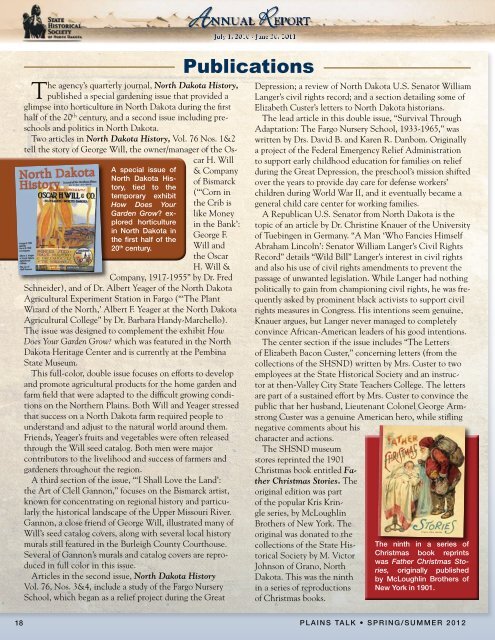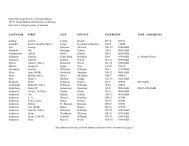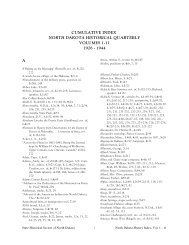Plains Talk Volume 43 Spring/Summer 2012(pdf - the State ...
Plains Talk Volume 43 Spring/Summer 2012(pdf - the State ...
Plains Talk Volume 43 Spring/Summer 2012(pdf - the State ...
You also want an ePaper? Increase the reach of your titles
YUMPU automatically turns print PDFs into web optimized ePapers that Google loves.
The agency’s quarterly journal, North Dakota History,<br />
published a special gardening issue that provided a<br />
glimpse into horticulture in North Dakota during <strong>the</strong> first<br />
half of <strong>the</strong> 20th century, and a second issue including preschools<br />
and politics in North Dakota.<br />
Two articles in North Dakota History, Vol. 76 Nos. 1&2<br />
tell <strong>the</strong> story of George Will, <strong>the</strong> owner/manager of <strong>the</strong> Os-<br />
A special issue of<br />
North Dakota History,<br />
tied to <strong>the</strong><br />
temporary exhibit<br />
How Does Your<br />
Garden Grow? explored<br />
horticulture<br />
in North Dakota in<br />
<strong>the</strong> first half of <strong>the</strong><br />
20 th century.<br />
car H. Will<br />
& Company<br />
of Bismarck<br />
(“‘Corn in<br />
<strong>the</strong> Crib is<br />
like Money<br />
in <strong>the</strong> Bank’:<br />
George F.<br />
Will and<br />
<strong>the</strong> Oscar<br />
H. Will &<br />
Company, 1917-1955” by Dr. Fred<br />
Schneider), and of Dr. Albert Yeager of <strong>the</strong> North Dakota<br />
Agricultural Experiment Station in Fargo (“‘The Plant<br />
Wizard of <strong>the</strong> North,’ Albert F. Yeager at <strong>the</strong> North Dakota<br />
Agricultural College” by Dr. Barbara Handy-Marchello).<br />
The issue was designed to complement <strong>the</strong> exhibit How<br />
Does Your Garden Grow? which was featured in <strong>the</strong> North<br />
Dakota Heritage Center and is currently at <strong>the</strong> Pembina<br />
<strong>State</strong> Museum.<br />
This full-color, double issue focuses on efforts to develop<br />
and promote agricultural products for <strong>the</strong> home garden and<br />
farm field that were adapted to <strong>the</strong> difficult growing conditions<br />
on <strong>the</strong> Nor<strong>the</strong>rn <strong>Plains</strong>. Both Will and Yeager stressed<br />
that success on a North Dakota farm required people to<br />
understand and adjust to <strong>the</strong> natural world around <strong>the</strong>m.<br />
Friends, Yeager’s fruits and vegetables were often released<br />
through <strong>the</strong> Will seed catalog. Both men were major<br />
contributors to <strong>the</strong> livelihood and success of farmers and<br />
gardeners throughout <strong>the</strong> region.<br />
A third section of <strong>the</strong> issue, “‘I Shall Love <strong>the</strong> Land’:<br />
<strong>the</strong> Art of Clell Gannon,” focuses on <strong>the</strong> Bismarck artist,<br />
known for concentrating on regional history and particularly<br />
<strong>the</strong> historical landscape of <strong>the</strong> Upper Missouri River.<br />
Gannon, a close friend of George Will, illustrated many of<br />
Will’s seed catalog covers, along with several local history<br />
murals still featured in <strong>the</strong> Burleigh County Courthouse.<br />
Several of Gannon’s murals and catalog covers are reproduced<br />
in full color in this issue.<br />
Articles in <strong>the</strong> second issue, North Dakota History<br />
Vol. 76, Nos. 3&4, include a study of <strong>the</strong> Fargo Nursery<br />
School, which began as a relief project during <strong>the</strong> Great<br />
Publications<br />
Depression; a review of North Dakota U.S. Senator William<br />
Langer’s civil rights record; and a section detailing some of<br />
Elizabeth Custer’s letters to North Dakota historians.<br />
The lead article in this double issue, “Survival Through<br />
Adaptation: The Fargo Nursery School, 1933-1965,” was<br />
written by Drs. David B. and Karen R. Danbom. Originally<br />
a project of <strong>the</strong> Federal Emergency Relief Administration<br />
to support early childhood education for families on relief<br />
during <strong>the</strong> Great Depression, <strong>the</strong> preschool’s mission shifted<br />
over <strong>the</strong> years to provide day care for defense workers’<br />
children during World War II, and it eventually became a<br />
general child care center for working families.<br />
A Republican U.S. Senator from North Dakota is <strong>the</strong><br />
topic of an article by Dr. Christine Knauer of <strong>the</strong> University<br />
of Tuebingen in Germany. “A Man ‘Who Fancies Himself<br />
Abraham Lincoln’: Senator William Langer’s Civil Rights<br />
Record” details “Wild Bill” Langer’s interest in civil rights<br />
and also his use of civil rights amendments to prevent <strong>the</strong><br />
passage of unwanted legislation. While Langer had nothing<br />
politically to gain from championing civil rights, he was frequently<br />
asked by prominent black activists to support civil<br />
rights measures in Congress. His intentions seem genuine,<br />
Knauer argues, but Langer never managed to completely<br />
convince African-American leaders of his good intentions.<br />
The center section if <strong>the</strong> issue includes “The Letters<br />
of Elizabeth Bacon Custer,” concerning letters (from <strong>the</strong><br />
collections of <strong>the</strong> SHSND) written by Mrs. Custer to two<br />
employees at <strong>the</strong> <strong>State</strong> Historical Society and an instructor<br />
at <strong>the</strong>n-Valley City <strong>State</strong> Teachers College. The letters<br />
are part of a sustained effort by Mrs. Custer to convince <strong>the</strong><br />
public that her husband, Lieutenant Colonel George Armstrong<br />
Custer was a genuine American hero, while stifling<br />
negative comments about his<br />
character and actions.<br />
The SHSND museum<br />
stores reprinted <strong>the</strong> 1901<br />
Christmas book entitled Fa<strong>the</strong>r<br />
Christmas Stories. The<br />
original edition was part<br />
of <strong>the</strong> popular Kris Kringle<br />
series, by McLoughlin<br />
Bro<strong>the</strong>rs of New York. The<br />
original was donated to <strong>the</strong><br />
collections of <strong>the</strong> <strong>State</strong> Historical<br />
Society by M. Victor<br />
Johnson of Grano, North<br />
Dakota. This was <strong>the</strong> ninth<br />
in a series of reproductions<br />
of Christmas books.<br />
The ninth in a series of<br />
Christmas book reprints<br />
was Fa<strong>the</strong>r Christmas Stories,<br />
originally published<br />
by McLoughlin Bro<strong>the</strong>rs of<br />
New York in 1901.<br />
18 <strong>Plains</strong> <strong>Talk</strong> • sPring/summer <strong>2012</strong>





